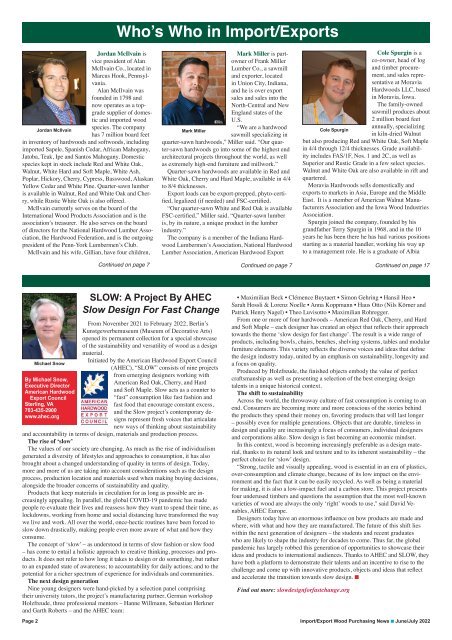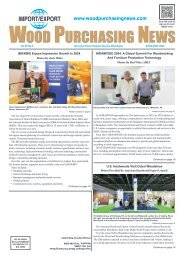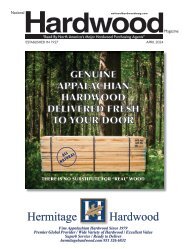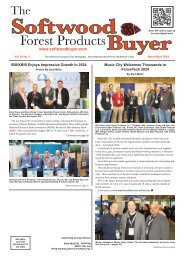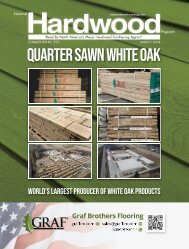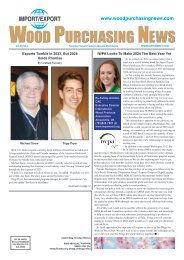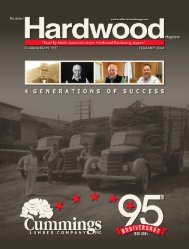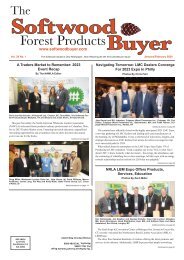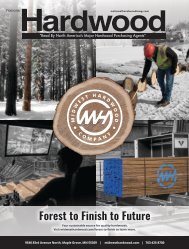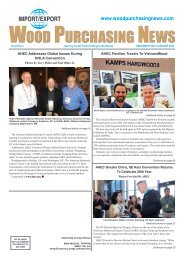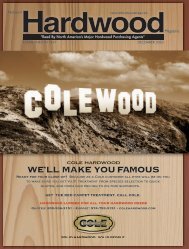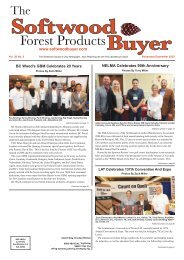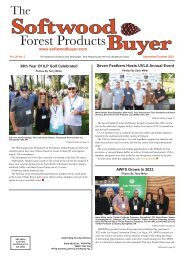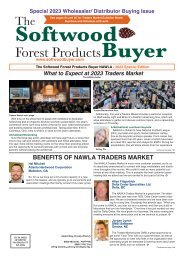Import/Export Wood Purchasing News - June- July 2022
Get updates from the IWPA World of Wood Convention, the AHEC Hardwood Pavilion in Spain, and the Dubai WoodShow in the latest issue of Import/Export Wood Purchasing News.
Get updates from the IWPA World of Wood Convention, the AHEC Hardwood Pavilion in Spain, and the Dubai WoodShow in the latest issue of Import/Export Wood Purchasing News.
Create successful ePaper yourself
Turn your PDF publications into a flip-book with our unique Google optimized e-Paper software.
Who’s Who in <strong>Import</strong>/<strong>Export</strong>s<br />
Jordan McIlvain is<br />
vice president of Alan<br />
McIlvain Co., located in<br />
Marcus Hook, Pennsylvania.<br />
Alan McIlvain was<br />
founded in 1798 and<br />
now operates as a topgrade<br />
supplier of domestic<br />
and imported wood<br />
species. The company<br />
Jordan McIlvain<br />
has 7 million board feet<br />
in inventory of hardwoods and softwoods, including<br />
imported Sapele, Spanish Cedar, African Mahogany,<br />
Jatoba, Teak, Ipe and Santos Mahogany. Domestic<br />
species kept in stock include Red and White Oak,<br />
Walnut, White Hard and Soft Maple, White Ash,<br />
Poplar, Hickory, Cherry, Cypress, Basswood, Alaskan<br />
Yellow Cedar and White Pine. Quarter-sawn lumber<br />
is available in Walnut, Red and White Oak and Cherry,<br />
while Rustic White Oak is also offered.<br />
McIlvain currently serves on the board of the<br />
International <strong>Wood</strong> Products Association and is the<br />
association’s treasurer. He also serves on the board<br />
of directors for the National Hardwood Lumber Association,<br />
the Hardwood Federation, and is the outgoing<br />
president of the Penn-York Lumbermen’s Club.<br />
McIlvain and his wife, Gillian, have four children,<br />
Mark Miller is partowner<br />
of Frank Miller<br />
Lumber Co., a sawmill<br />
and exporter, located<br />
in Union City, Indiana,<br />
and he is over export<br />
sales and sales into the<br />
North-Central and New<br />
England states of the<br />
U.S.<br />
“We are a hardwood<br />
Mark Miller<br />
sawmill specializing in<br />
quarter-sawn hardwoods,” Miller said. “Our quarter-sawn<br />
hardwoods go into some of the highest end<br />
architectural projects throughout the world, as well<br />
as extremely high-end furniture and millwork.”<br />
Quarter-sawn hardwoods are available in Red and<br />
White Oak, Cherry and Hard Maple, available in 4/4<br />
to 8/4 thicknesses.<br />
<strong>Export</strong> loads can be export-prepped, phyto-certified,<br />
legalized (if needed) and FSC-certified.<br />
“Our quarter-sawn White and Red Oak is available<br />
FSC-certified,” Miller said. “Quarter-sawn lumber<br />
is, by its nature, a unique product in the lumber<br />
industry.”<br />
The company is a member of the Indiana Hardwood<br />
Lumbermen’s Association, National Hardwood<br />
Lumber Association, American Hardwood <strong>Export</strong><br />
Cole Spurgin is a<br />
co-owner, head of log<br />
and timber procurement,<br />
and sales representative<br />
at Moravia<br />
Hardwoods LLC, based<br />
in Moravia, Iowa.<br />
The family-owned<br />
sawmill produces about<br />
2 million board feet<br />
annually, specializing<br />
Cole Spurgin<br />
in kiln-dried Walnut<br />
but also producing Red and White Oak, Soft Maple<br />
in 4/4 through 12/4 thicknesses. Grade availability<br />
includes FAS/1F, Nos. 1 and 2C, as well as<br />
Superior and Rustic Grade in a few select species.<br />
Walnut and White Oak are also available in rift and<br />
quartered.<br />
Moravia Hardwoods sells domestically and<br />
exports to markets in Asia, Europe and the Middle<br />
East. It is a member of American Walnut Manufacturers<br />
Association and the Iowa <strong>Wood</strong> Industries<br />
Association.<br />
Spurgin joined the company, founded by his<br />
grandfather Terry Spurgin in 1968, and in the 10<br />
years he has been there he has had various positions<br />
starting as a material handler, working his way up<br />
to a management role. He is a graduate of Albia<br />
Continued on page 7 Continued on page 17<br />
Continued on page 7<br />
Michael Snow<br />
By Michael Snow,<br />
Executive Director<br />
American Hardwood<br />
<strong>Export</strong> Council<br />
Sterling, VA<br />
703-435-2900<br />
www.ahec.org<br />
SLOW: A Project By AHEC<br />
Slow Design For Fast Change<br />
From November 2021 to February <strong>2022</strong>, Berlin’s<br />
Kunstgewerbemuseum (Museum of Decorative Arts)<br />
opened its permanent collection for a special showcase<br />
of the sustainability and versatility of wood as a design<br />
material.<br />
Initiated by the American Hardwood <strong>Export</strong> Council<br />
(AHEC), “SLOW” consists of nine projects<br />
from emerging designers working with<br />
American Red Oak, Cherry, and Hard<br />
and Soft Maple. Slow acts as a counter to<br />
“fast” consumption like fast fashion and<br />
fast food that encourage constant excess,<br />
and the Slow project’s contemporary designs<br />
represent fresh voices that articulate<br />
new ways of thinking about sustainability<br />
and accountability in terms of design, materials and production process.<br />
The rise of ‘slow’<br />
The values of our society are changing. As much as the rise of individualism<br />
generated a diversity of lifestyles and approaches to consumption, it has also<br />
brought about a changed understanding of quality in terms of design. Today,<br />
more and more of us are taking into account considerations such as the design<br />
process, production location and materials used when making buying decisions,<br />
alongside the broader concerns of sustainability and quality.<br />
Products that keep materials in circulation for as long as possible are increasingly<br />
appealing. In parallel, the global COVID-19 pandemic has made<br />
people re-evaluate their lives and reassess how they want to spend their time, as<br />
lockdowns, working from home and social distancing have transformed the way<br />
we live and work. All over the world, once-hectic routines have been forced to<br />
slow down drastically, making people even more aware of what and how they<br />
consume.<br />
The concept of ‘slow’ – as understood in terms of slow fashion or slow food<br />
– has come to entail a holistic approach to creative thinking, processes and products.<br />
It does not refer to how long it takes to design or do something, but rather<br />
to an expanded state of awareness; to accountability for daily actions; and to the<br />
potential for a richer spectrum of experience for individuals and communities.<br />
The next design generation<br />
Nine young designers were hand-picked by a selection panel comprising<br />
their university tutors, the project’s manufacturing partner, German workshop<br />
Holzfreude, three professional mentors – Hanne Willmann, Sebastian Herkner<br />
and Garth Roberts – and the AHEC team:<br />
• Maximilian Beck • Clémence Buytaert • Simon Gehring • Hansil Heo •<br />
Sarah Hossli & Lorenz Noelle • Anna Koppmann • Haus Otto (Nils Körner and<br />
Patrick Henry Nagel) • Theo Luvisotto • Maximilian Rohregger.<br />
From one or more of four hardwoods – American Red Oak, Cherry, and Hard<br />
and Soft Maple – each designer has created an object that reflects their approach<br />
towards the theme ‘slow design for fast change’. The result is a wide range of<br />
products, including bowls, chairs, benches, shelving systems, tables and modular<br />
furniture elements. This variety reflects the diverse voices and ideas that define<br />
the design industry today, united by an emphasis on sustainability, longevity and<br />
a focus on quality.<br />
Produced by Holzfreude, the finished objects embody the value of perfect<br />
craftsmanship as well as presenting a selection of the best emerging design<br />
talents in a unique historical context.<br />
The shift to sustainability<br />
Across the world, the throwaway culture of fast consumption is coming to an<br />
end. Consumers are becoming more and more conscious of the stories behind<br />
the products they spend their money on, favoring products that will last longer<br />
– possibly even for multiple generations. Objects that are durable, timeless in<br />
design and quality are increasingly a focus of consumers, individual designers<br />
and corporations alike. Slow design is fast becoming an economic mindset.<br />
In this context, wood is becoming increasingly preferable as a design material,<br />
thanks to its natural look and texture and to its inherent sustainability – the<br />
perfect choice for ‘slow’ design.<br />
“Strong, tactile and visually appealing, wood is essential in an era of plastics,<br />
over-consumption and climate change, because of its low impact on the environment<br />
and the fact that it can be easily recycled. As well as being a material<br />
for making, it is also a low-impact fuel and a carbon store. This project presents<br />
four underused timbers and questions the assumption that the most well-known<br />
varieties of wood are always the only ‘right’ woods to use," said David Venables,<br />
AHEC Europe.<br />
Designers today have an enormous influence on how products are made and<br />
where, with what and how they are manufactured. The future of this shift lies<br />
within the next generation of designers – the students and recent graduates<br />
who are likely to shape the industry for decades to come. Thus far, the global<br />
pandemic has largely robbed this generation of opportunities to showcase their<br />
ideas and products to international audiences. Thanks to AHEC and SLOW, they<br />
have both a platform to demonstrate their talents and an incentive to rise to the<br />
challenge and come up with innovative products, objects and ideas that reflect<br />
and accelerate the transition towards slow design. n<br />
Find out more: slowdesignforfastchange.org<br />
Page 2 <strong>Import</strong>/<strong>Export</strong> <strong>Wood</strong> <strong>Purchasing</strong> <strong>News</strong> n <strong>June</strong>/<strong>July</strong> <strong>2022</strong>


